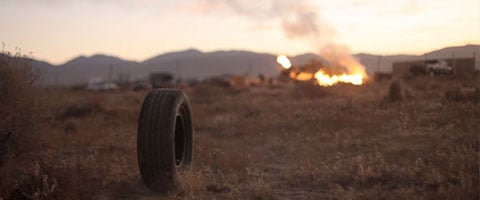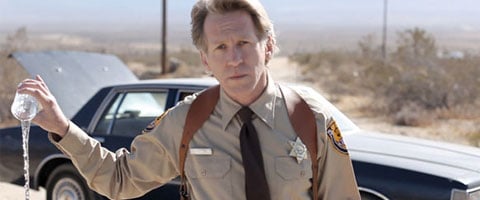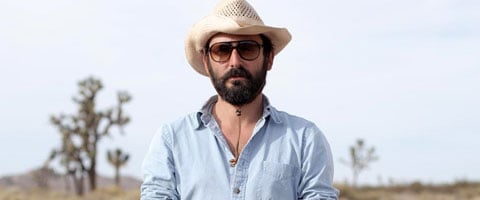Interview: Rubber Writer-Director Quentin Dupieux

In an industry obsessed with making movies about friends with benefits, alien invasions and haunted houses, who’s got the guts to make a movie about a tire with the power to make people’s heads explode? That man is Quentin Dupieux and while he is billed as Rubber’s director, writer, editor, composer and cinematographer, he much prefers the title, “stupid creator.”
Rubber is the story of Robert, an abandoned tire who magically comes to life, explores the land before discovering his ability to make things explode. After rolling into a nearby motel, he takes a liking not only to a pretty lady he meets along the way named Sheila (Roxane Mesquida), but also to blowing up people's heads. Meanwhile, way out in the distance, a group of spectators are watching this “movie” about a tire on a killing spree.
Okay, it certainly sounds a bit strange, but it really does make quite a bit of sense when you watch Rubber in its entirety – or does it? While the film oozes with messages and implications about the filmmaking industry, Dupieux insists he just wrote to his liking. After just three weeks of writing, he loaded up his brand new Canon 5D and made his movie in the simplest, quickest and most functional manner possible, which is just the way he likes it. Read all about Dupieux’s experience bringing Robert to life in the interview below.

Let’s start with the most obvious question. How did you get the tire to move like that?
Quentin Dupieux: Yeah, everybody’s asking, which is funny because there are so many movies with incredible special effects and this is just a tire rolling [laughs]. Basically, we had one prototype with shitty electronics; it’s like a hamster in it. It’s like a small car, a small, very heavy remote control car. It’s not a car, but it’s something that goes inside and pushes like a hamster. That’s it. [Laughs] But that’s just for like 20 shots. Everything else, it’s just a puppeteer operating the tire with two fingers off frame. That’s really easy. But I guess the magic works because you see this wide shot where the tire rolls and then stops and rolls again, so you think, ‘Okay! It’s working,’ and then for every other shot, even if it’s close-ups and obviously someone is off frame doing it, you forgot about it – maybe, I don’t know.
It’s very effective.
Thank you. It was like going back to the 20s. I hate CGI. I can watch movies with CGI; what I mean is I don’t want to do that. I don’t want to shoot something and then work it on a computer. I like to shoot something real, so we never thought about any digital solutions. We did some tests with wires, for example, and it was not good because a tire, it’s heavy, so it was really hard to operate the tire with some strings, so we decided to create this thing. We had like three prototypes [laughs]. I mean, we had two first prototypes and they were not able to work. It was a nightmare. And then, just before the first day of the shoot, we had this very good prototype, which was working and basically, it was just able to roll, make a stop and roll again.
Your Daily Blend of Entertainment News
How do you go about shooting a tire? It’s one thing to shoot a conversation between two people, but how do you frame a tire in a way that’s effective.
That was part of the excitement. I shot with a still camera, the Canon 5D, and it’s a small camera and it’s so easy to operate. Suddenly, you can go everywhere. You just have to put it on the floor and then you’re ready to do a shot. Three months before the real shoot, I just bought the 5D and I was in Corsica in the South of France and I was doing some tests with a tire and I was just by myself in a field. I was throwing the tire and then shooting it and when we watched this on the computer, it was already a movie. It was like, ‘Okay. We don’t need more. It’s a movie,’ and then we just transferred this footage onto 35mm and we watched this in a theater and it was a movie. It was incredible. It’s just me with a tire and it was incredible on screen. Your question was about how it is to shoot a tire, but I think because this camera is very different from every other camera, it captures light in a special way and because it’s so small it was really easy to create the language around the tire because, like I said, it was like, ‘Okay, let’s go on the floor and do this. Click. Shot. It’s done.’ That would have been a nightmare with a big camera.
Not to mention, it’s less expensive, too.
Yeah, of course. You can find a big camera for nothing. It’s not a money thing. It’s more like, for my first feature we were shooting on 35mm and I just realized that it’s very slow. You do a shot here and then you say, ‘Okay, I want to go here,’ and you need an hour because you have to change the lighting, you need three assistants for the camera and you have to change everything around. It’s really complicated. With this camera, of course it’s cheaper, but the good thing is it’s faster. Everybody, the crew and the actors, were amazed by this because they used to wait a lot on a shoot and this was just like we were shooting all day long. It was just like shooting, shooting, shooting and nobody was waiting. So, to me, that’s the revolution. I do think Robert looks great. Usually, when I see a shoot in the street, it looks ridiculous. They have like 12 trucks and all this lighting, all these things. It’s really heavy to make a movie. Now we can make a movie with almost nothing, which is really exciting I think.

Did anything like, let’s say Attack of the Killer Tomatoes, influence your film?
No, the main influence was Duel, Steven Spielberg, the truck. That was the only reference because, I don’t know if you watched it recently, it’s incredible because it’s managed to create fear with nothing. It’s just a truck. It does nothing special, but the truck is dirty, it’s an old truck, but it’s just a truck! It’s just a guy driving and there’s a truck behind him and you get scared! That’s amazing. It’s just editing basically because he did tons of shots like car driving, truck driving, interior car, exterior truck and then editing and then there’s tension and it’s only editing. It’s crazy.
Robert’s a pretty malicious character, but he’s also likeable. What was your inspiration for that?
Honestly, when I wrote it, it was only supposed to be an evil character. In my mind it was like, ‘Okay, it’s just the bad guy,’ but then, when I started to shoot it, I had to deal with a tire and there’s nothing evil about a tire. So I had to change my mind a little bit (laughs), and when we did the first tests with the remote controlled tire – I had the camera attached to a stick – and it was just following the remote controlled tire in the field and, at this point, the tire was like a dog. The way it was rolling and behaving in the field, it was like a dog. So I decided, ‘Okay, it’s like a dog. It has to be like a dog.’ That’s why there’s shots where it drinks water, things like that. Suddenly, it was not just an evil character. It was more like a stupid dog. That was the inspiration.
Shelia is pretty likable, too. She doesn’t even have many lines, but between hr deliverance and her accent, they’re funny. Was that intentional?
No. It’s just a technical aspect. Because we did the film with French financing, at some point we needed at least one French character in the cast, so we had to hire Roxane Mesquida for that because she was living in LA and so it was perfect. But no, I was not looking for a French girl trying to speak in English. She had to take a coach and try to work her accent. Even if it’s not that important, I think she’s doing great.

Well, it worked out pretty well! Some of her moments got some big laughs.
To me it was a bit strange because I was talking in French to her and suddenly, when the camera was rolling, she was speaking in English and also the part was a little bit weak in a way. The only comedy she has, it’s the end scene in the truck.
SPOILER ALERT
Can you tell us about that one spectator who isn’t quite as naive as the rest? Is there a message there you’re trying to get across?
It’s just because we need at least one guy in the theater to make the movie exist. I realized that because my first feature, Steak, it was shot in Canada, but it was in French. They did a big release, like 500 theaters in France, so that was huge and nobody really got interested in that movie because the promotion was terrible. They were trying to sell it as a big family comedy and it was not so the movie was running in some theaters, but with no one watching. I was sneaking into screenings sometimes to see people’s reaction and one day, I just sneaked into a theater and the movie was alone. It was rolling, but no one was watching and I felt like, ‘Wow, this is crazy,’ you know? [Laughs] If no one’s watching, what’s the point? So I think the idea came here; that’s why the guy is still alive, he wants to watch the end even if he doesn’t really like the movie, but he wants to watch and that’s why the movie has to keep on.

Even before the end, he stands out from that group right from the start, so I suspected there was a message there even from the beginning of the film.
We can find messages everywhere. For example, another journalist asked me, ‘Okay, why, at some point, do the spectators get poisoned?’ I just had the idea because, at one point, I was writing and I thought like, ‘Okay, I’m bored with the spectators. I don’t want to see them anymore.’ That’s the magic of writing; you can do whatever you want. ‘Okay, so I’m going to poison the spectators because I don’t want to see them anymore!’ [Laughs] But that’s it! You can find a meaning here, but I’m just doing this for fun. The script has been written in three weeks. It was almost writing, writing, writing, "Okay, let’s shoot." So, yes, now I know; I watched it like 200 times. I can find, like you, some meanings like, "Oh yeah, this, this makes sense actually!"
END SPOILER ALERT
So then were you even aiming for a direct meaning with the speech in the beginning, the no reason speech? Do you really believe that?
No, it’s a joke! It’s a joke, but also it was supposed to be like a warning and also a good way to get people’s attention. I had the idea of this monologue because when I started to write the story of the tire, I was like, ‘Okay, do I have to explain why the tire is alive,’ because you cannot start a movie with a living tire; it makes no sense. [Laughs] You have to explain in a way. So I decided I’m going to show his first steps, like the birth. You see him unanimated and then, oh, he comes to life and starts rolling. But that was not enough, still, so I decided I’m going to write a monologue to explain the whole thing basically to sell to the audience the idea because that was the heartbeat. The tire is alive and he’s going to kill people by just shaking; that was hard to sell, so I think the monologue is here for that and I think it works because I think the monologue is funny, so it gives you the tone of the movie. It’s like, ‘This is the tone, this is the set up, so now if you like it, welcome, if you don’t, you should leave because this is the movie.’
Why use a cop to sell the idea?
Probably randomly. I just like the uniform because there’s something very filmic about a uniform, but also it’s ridiculous.
Do you feel the uniform reflects American culture in any way?
No, I don’t think like that, but also I was obviously, without knowing it, making references [to] the old 80s. I chose old cop cars, not modern ones. I don’t know why, but it’s probably because I grew up with these movies.
Yeah, this cop, I don’t know if you feel the same, but we saw him so many times. It’s already your friend; we know him. It’s “the cop.” [Laughs] You know? He’s the movie cop! I mean, to me, it’s like that. It’s a generic character, like, oh, movie cop, beige [uniform] like the sheriff, duh! With the desert, it works. [Laughs] But the main reason, I know I’m a little bit obsessed by uniforms. There’s something really filmic about it and my first movie, Steak, also starts with a military guy. There’s something I like about uniforms in movies. I don’t know why.

As for Robert, he seems to have a little WALL-E in him.
Yeah, the whole birth scene, when he wakes up and discovers things, that was, to me, I was calling that the WALL-E part. Even if I’m not a big WALL-E fan, but it’s a bit the same. You’re watching something and you’re just watching. Something is doing something and you’re watching; there’s no story, you know? You just watch something alive doing something that’s funny.
Are you willing to go bigger in terms of the scale of your production or do you want to stick with the Canon 5D and something more intimate?
No, I want to stick to this format because I like to do everything by myself and I like to be the only one in charge in a way and when you spend someone else’s money, it’s different. You have some kind of pressure and no, I don’t want to do that job. I don’t want to be a director. I’d rather be like a stupid creator because being a director, it’s a different job. You have to deal with many other things; you have to deal with the writer, you have to deal with the producers, you have to deal with the DOP (director of photography), you have to deal with some other producers; it’s something different. It’s more like being in charge of a lot of money. I’m trying to make funny art and the movie industry is not about funny art.
What’s your next project?
I have two. There’s one I’m shooting in LA. It’s called Wrong. I cannot talk about it. It’s hard to describe, but it’s still funny and special. And the other one might be shot in France next year.
Is it hard to describe Wrong in the same way it seems hard to describe Rubber? I’m trying to imagine you pitching the story of a head exploding tire to financers.
[Laughs] Yeah, but this was quite easy to pitch. Even if they were laughing at me like, ‘Are you serious? You want to do a movie with a living tire?’ It was easy to pitch. This is quite a stronger pitch; it’s a killing tire. That’s already funny, I guess. The new one, I just wrote it, and I still don’t have a good pitch.
Did you write that one in three weeks, too?
No, a little bit more. It’s a bit bigger.
Staff Writer for CinemaBlend.

